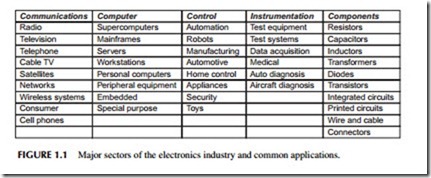ELECTRONICS: THE BIG PICTURE
Before we get into the nitty-gritty of how electronic equipment works, you really need to know the entire scope of electronics. It is a huge industry and recent figures seem to show that it is one of the biggest, if not the biggest, markets in the entire world. To get a grasp of how big the industry is, we normally break it down into segments of specializations. There are five major fields of electronics: communications, computers, control, instrumentation and measurement, and components. Any electronic product or device will easily fall into one of those categories. In some cases, the product may overlap two or more or all of those categories. Take a look at Figure 1.1 , which shows each of these segments of electronics and the products and technologies that are part of them.
Communications
Communications is the oldest segment of electronics and still the largest. Electronics actually started with communications–specifically telegraph, tele- phone, and radio–and grew from there. A lot of this book is about communications because it is such a huge segment of the industry and one that we use the most. And don’t forget, communications comes in both wired and wireless forms. Wired systems include the vast telephone network, cable TV systems, and computer networks, including the Internet. Wireless systems comprise all of the radio, cell phone, television, satellite, radar, and other wireless systems.
Computers
Computers have only been around since the late 1940s and early 1950s but what an impact they have had on the way we work. Today virtually everyone uses and even owns a personal computer. And then there are all the larger and more powerful computers such as the servers that manage all of our networks, the mainframes still used by government and big business to manage huge databases, as well as the high-speed supercomputers that still do an amazing amount of scientific, engineering, and mathematical design and research. But the computer we are going to talk about most in this book is the embedded controller. These are small single-chip digital computers called microcomputers or just micros that are literally part of every electronic product. These are miniature digital computers dedicated to a specific function inside the products in which they exist.
Control
Control is a broad general term for monitoring and control. Monitoring, of course, means sensing various physical characteristics such as temperature, humidity, physical position, motor shaft speed, or light level. Electronic devices called sensorsor transducers convert these physical characteristics into electrical signals
which allow us to monitor them. Control refers to managing and exercising some degree of influence over items such as motors, lights, relays, heating elements, and other devices. Most monitoring and control functions take place in factories, chemical plants, refineries, and food processing operations. Control also occurs in the home, an example being your electronic thermostat. It also shows up in electromechanical products like a DVD player. Electronic controls appear in appliances, home control systems, security systems, automobiles, and even toys. Robots are another major segment of the control industry.
Instrumentation
Instrumentation refers to the field involved with testing and measuring electronic equipment and other mechanical or electronic items. It refers to the test instruments like volt meters, oscilloscopes, and spectrum analyzers as well as the large automated test systems used for mass testing and measuring of other devices. Instrumentation refers to data acquisition systems, medical tests and measurements, and a wide range of other products.
Components
All of the electronic products that make up each of the four major segments of the electronic industry are made up of various electronic components. In the past, electronic products were made of the individual discrete components such as resistors, capacitors, diodes, and transistors. Today most electronic equipment is made with one or more integrated circuits surrounded by a sprinkling of those other so-called discrete components. No longer can we access most individual components or circuits since they are sealed within integrated circuits or chips. Just keep in mind that there is a whole industry centered on making these electronic components that are in turn made available to the manufacturers of the end electronic equipment in each of the four major categories just described.
